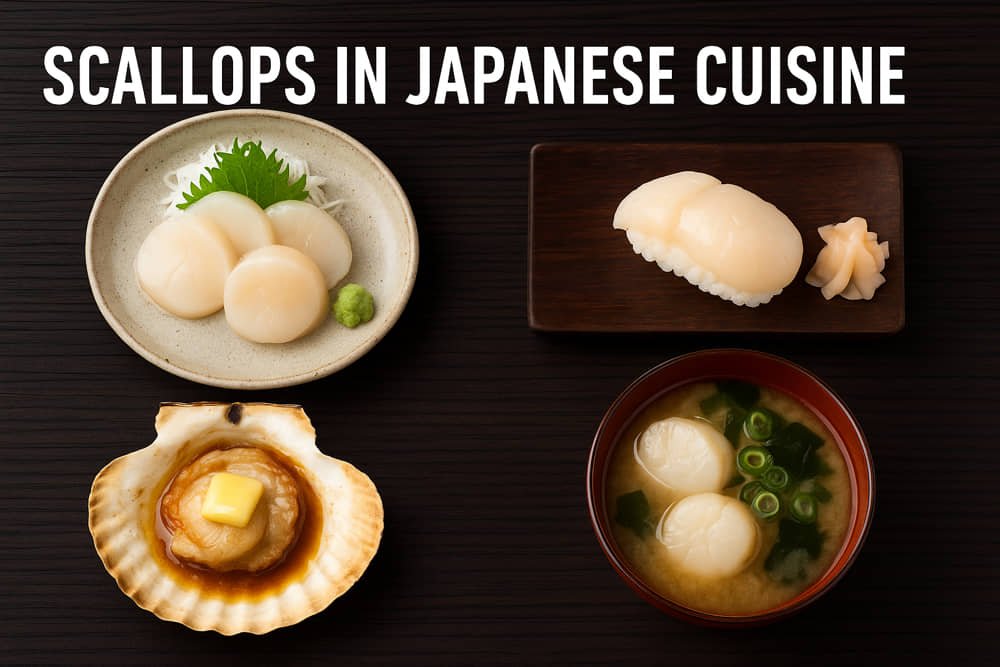Scallops in Japanese cuisine are more than just a delicacy—they’re a celebration of purity, balance, and the ocean’s natural sweetness. Known for their soft texture and subtle umami, scallops (hotate in Japanese) are used in a wide variety of dishes that showcase both the simplicity and depth of Japanese culinary traditions.
From the clean slices of raw scallops in sashimi to the smoky aroma of grilled hotate on the shell, scallops appear in everything from elegant sushi counters to bustling street food stalls. Their versatility and delicate profile make them a favorite among chefs and home cooks alike.
In this article, we’ll explore the cultural significance of scallops in Japan, how they’re prepared in popular dishes like sashimi and sushi, and why they remain a treasured ingredient across generations.
Contents
The Cultural Significance of Scallops in Japan
Scallops hold a unique place in Japanese food culture, especially in coastal regions like Hokkaido, where the waters are rich with premium seafood. In Hokkaido, scallops are a symbol of pride, often featured at regional food festivals and local markets. The area’s cold, nutrient-rich waters produce plump, sweet hotate that are considered among the best in the world.
Scallops are also appreciated for their spiritual and ceremonial value. In traditional Japanese cuisine (washoku), ingredients are chosen not just for flavor but for their connection to nature and seasonality. Scallops harvested during the colder months are especially prized for their sweetness and tenderness.
Beyond fine dining, scallops are embraced in everyday cooking. They are grilled at summer festivals, served raw in sushi bars, or simmered in comforting winter stews. Their presence across various culinary settings speaks to their adaptability and deep cultural roots.
Sashimi: The Raw Elegance of Scallops
When served raw as sashimi, scallops offer a pure and luxurious taste experience. Unlike other seafood, scallops don’t have an overpowering flavor—what they offer instead is a creamy texture and a natural sweetness that melts in your mouth.
Preparing scallops for sashimi requires skill and attention to freshness. Only the highest-quality, sashimi-grade scallops are used, often delivered the same day they’re caught. Chefs slice them with precision, highlighting their translucence and firmness. They may be served simply with a dash of soy sauce, a brush of yuzu zest, or a sprinkle of sea salt.
Sashimi-grade scallops are typically enjoyed in minimalist settings, allowing diners to focus entirely on flavor and texture. When choosing sashimi-grade scallops, freshness and sourcing matter. Learn more in our guide to sashimi-grade seafood.
Sushi with Scallops: Delicate and Balanced
Scallops are a beloved ingredient in many types of sushi thanks to their subtle sweetness and smooth, velvety texture. In nigiri sushi, a raw scallop is placed atop a small bed of vinegared rice, often garnished with a touch of wasabi, a thin slice of citrus, or even a light brushing of soy sauce. The result is a bite that’s both refined and flavorful, emphasizing balance and freshness.
Another popular variation is gunkan maki, where chopped raw scallops are mixed with creamy mayonnaise or spicy sauce and placed inside a nori-wrapped rice base. This style allows for creative flavor combinations while still honoring the scallop’s gentle nature.
If you’re curious whether it’s safe to enjoy scallops raw, check out our complete guide on eating raw scallops safely. Understanding how to select and prepare raw seafood properly is essential for the best experience.
Grilled Scallops (Hotate-yaki): A Street Food Favorite
While raw preparations showcase the scallop’s natural sweetness, grilled scallops—known as hotate-yaki—offer a savory, smoky counterpart. Commonly found at street stalls and food festivals, scallops are grilled directly in their shells with butter, soy sauce, and sometimes a splash of sake. As they cook, the butter melts into the juices, creating a rich, umami-packed broth.
The heat caramelizes the edges of the scallop while keeping the center tender. This contrast of textures makes grilled scallops a standout favorite among locals and tourists alike. Served piping hot with chopsticks or skewers, hotate-yaki is a perfect example of how Japanese cuisine enhances natural ingredients through simple but effective techniques.
Scallops in Japanese Soups and Stews
Beyond sushi and sashimi, scallops play a flavorful role in Japanese soups and hot pots. Their natural umami enriches the broth, making them a popular choice for dishes like miso soup or nabemono (Japanese hot pot). Thinly sliced scallops add depth to the broth, while their soft texture blends harmoniously with vegetables, tofu, and seaweed.
Dried scallops, or hoshi-gai, are also used to create concentrated stock (dashi) for traditional soups. When rehydrated, they release intense seafood flavor that elevates even the simplest recipes.
In winter months, hot scallop stews are especially comforting, providing both warmth and nourishment. Whether used fresh or dried, scallops in Japanese soups exemplify the cuisine’s dedication to extracting maximum flavor from minimal ingredients.
Tips for Choosing and Preparing Scallops for Japanese Dishes
To fully enjoy scallops in Japanese cuisine, selecting the right type and preparing them properly is essential. When shopping for scallops, look for firm, translucent flesh and a clean, ocean-like scent. The most highly prized scallops often come from Hokkaido, known for its cold, clean waters that produce plump, sweet hotate.
For raw dishes like sashimi and sushi, only purchase scallops labeled as sashimi-grade. These have been handled under strict sanitary conditions to ensure safety when consumed raw. If unsure, ask your fishmonger about the origin and handling of the scallops.
Before using scallops in Japanese dishes, gently rinse them in cold water and pat them dry with a paper towel. Avoid overcooking when grilling or simmering, as scallops can quickly become rubbery. The goal is to highlight their natural tenderness and subtle flavor, whether raw, grilled, or lightly poached.
Conclusion
Scallops in Japanese cuisine embody the values of simplicity, seasonality, and respect for natural flavors. Whether served raw as delicate sashimi, paired with rice in sushi, grilled on the shell, or simmered in comforting soups, scallops offer a uniquely versatile ingredient that reflects the heart of Japanese culinary tradition.
If you’ve never tried scallops in a Japanese dish, consider exploring them at a sushi bar or preparing them at home using the tips above. With their sweet taste and delicate texture, scallops are sure to become a highlight of your Japanese food experience.



